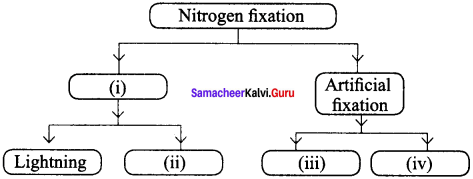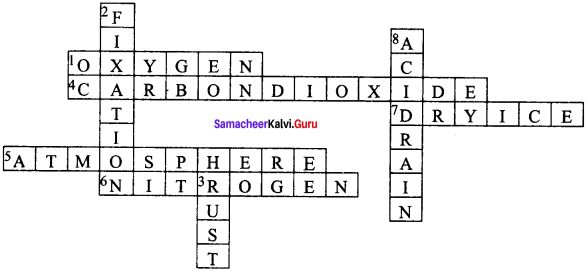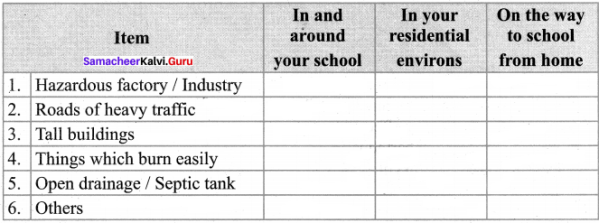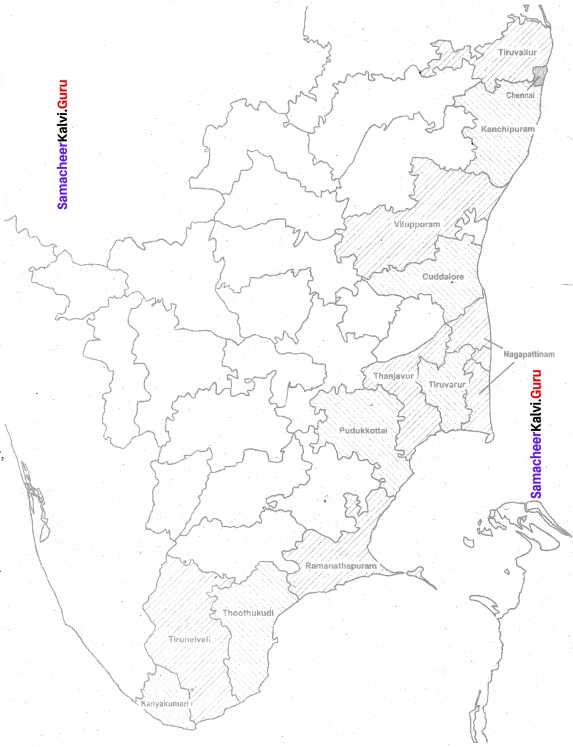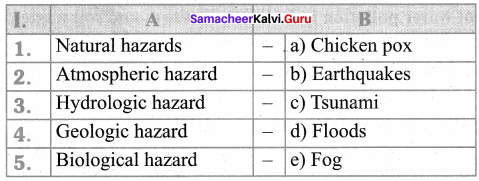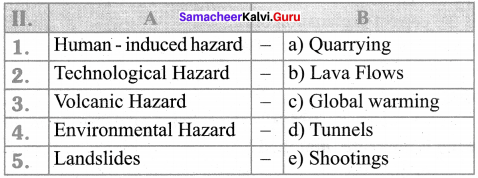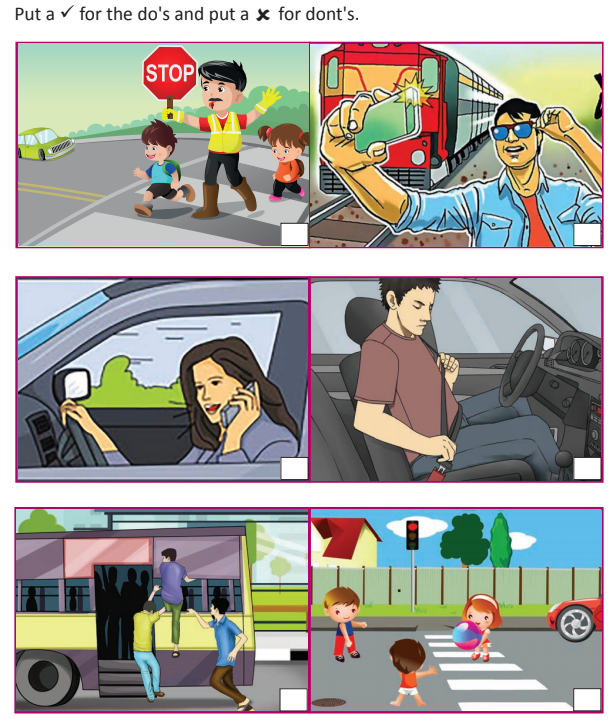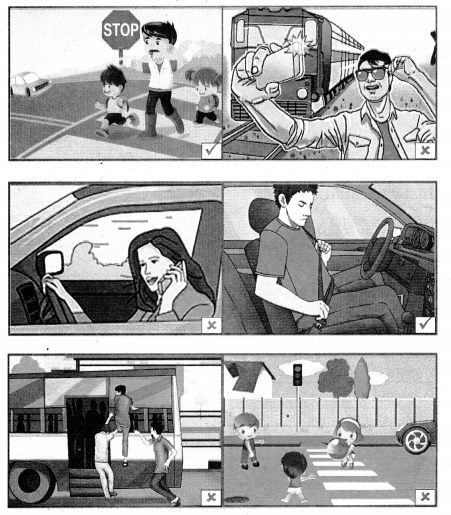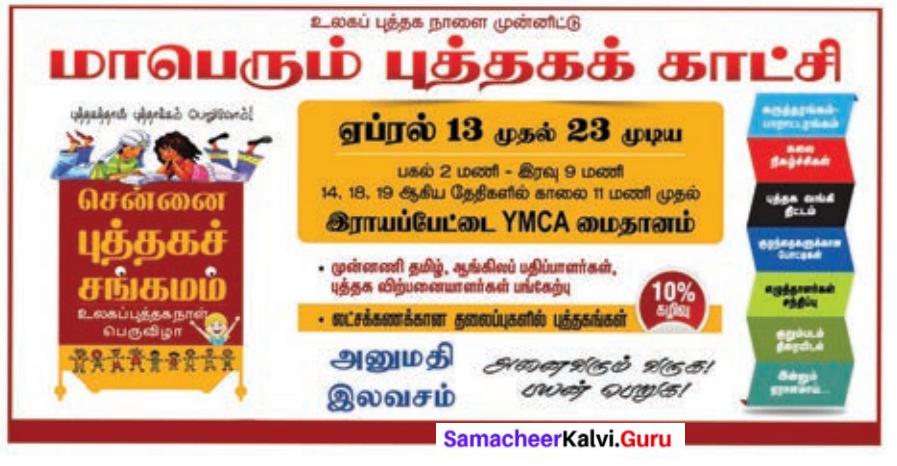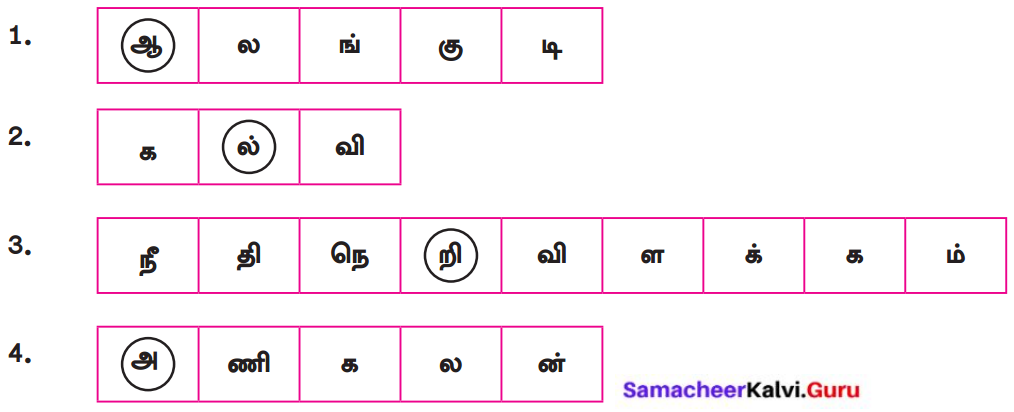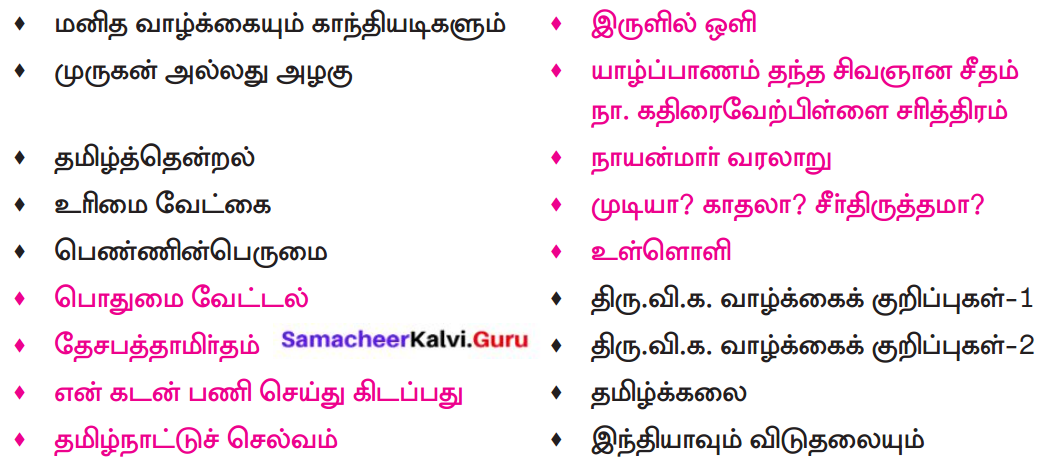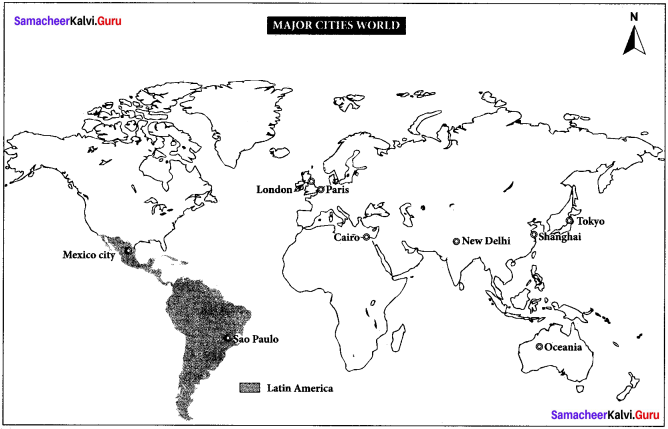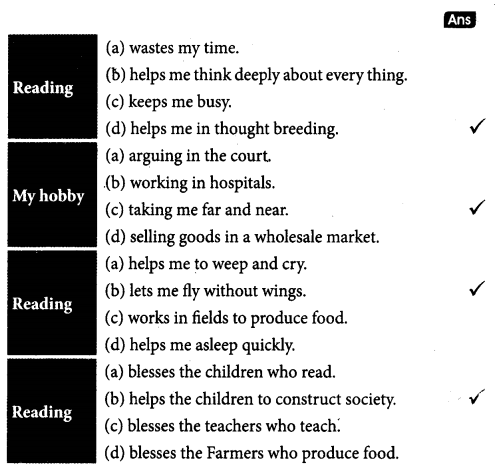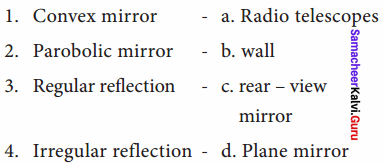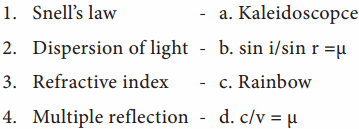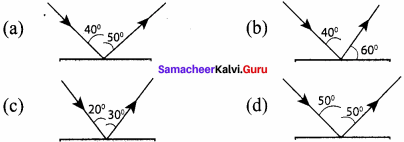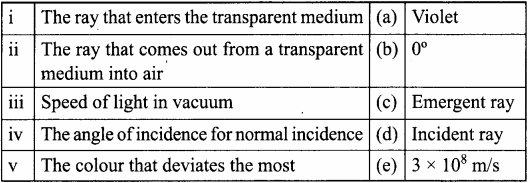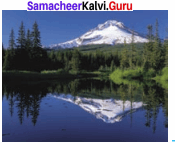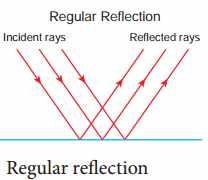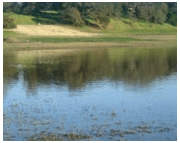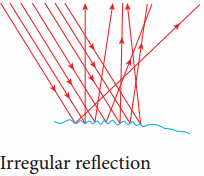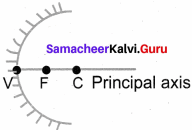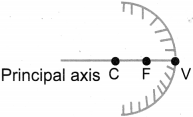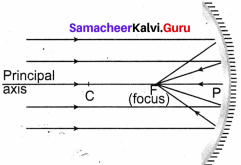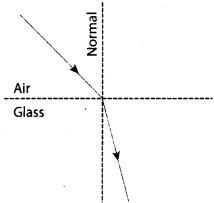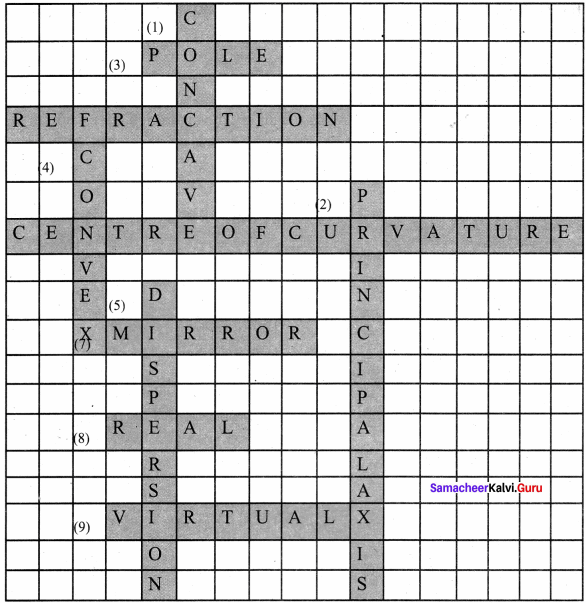You can Download Samacheer Kalvi 8th Social Science Book Solutions Guide Pdf, Tamilnadu State Board help you to revise the complete Syllabus and score more marks in your examinations.
Tamilnadu Samacheer Kalvi 8th Social Science History Solutions Term 2 Chapter 2 Development of Industries in India
Samacheer Kalvi 8th Social Science Development of Industries in India Textbook Evaluation
I. Choose the correct answer
Development Of Industries In India 8th Standard Question 1.
Which of the following activities of the people will not come under handy craft?
(a) Carving statues out of stone
(b) Making bangles with glass
(c) Weaving silk sarees
(d) Smelting of iron
Answer:
(d) Smelting of Iron
Question 2.
The oldest industry in India was ……….. industry.
(a) Textile
(b) Steel
(c) Electrical
(d) Fertilizers
Answer:
(a) Textile
Question 3.
The woolen and leather factories became prominent in …………
(a) Bombay
(b) Ahmadabad
(c) Kanpur
(d) Decca
Answer:
(c) Kanpur
Question 4.
What was the aim of first Three Five year Plans of India?
(a) To control population growth
(b) To reduce illiteracy rate
(c) To built a strong industrial base
(d) To empower the women
Answer:
(c) To built a strong industrial base
Question 5.
What was not the reason for the decline of Indian Industries?
(a) Loss of royal patronage
(b) Competition of machine made goods
(c) Industrial policy of India
(d) Trading policy of British
Answer:
(c) Industrial policy of India
II. Fill in the Blanks
- ……….. was the integral part in the life of the people.
- Industrial revolution took place in …………
- The Assam Tea Company was founded in ………………
- Jute industry was started in the Hoogly Valley at ………. near Calcutta.
- ………… shortened the distance between Europe and India.
Answer:
- Craft
- 1948
- 1939
- Rishra
- Suez Canal
III. Match the following
- Tavernier – Drain Theory
- Dacca – Paper mill
- Dadabai Naoroji – Artisan
- Ballygunj – Muslin
- Smiths – French traveller
Answer:
- Tavernier – French traveller
- Dacca – Muslin
- Dadabai Naoroji – Drain Theory
- Ballygunj – Paper mill
- Smiths – Artisan
IV. State True or False
- India was famous for cotton and silk cloths.
- The railway was introduced in India by the British.
- Steel was first manufactured by modem methods at Jamshedpur.
- The industrial policy of 1948, brought mixed economy in industrial sector.
- The tenth and eleventh five year plans witnessed a high growth rate of Agricultural production.
Answer:
- True
- True
- False
- True
- False
V. Consider the following statements and tick the appropriate answer:
Question 1.
Which of the following statements are correct?
(i) According to Edward Baines, ‘The birth place of cotton manufacture is in England’.
(ii) Before mechanised industry handicrafts was the second largest source of employment in rural India.
(iii) Saurashtra was known for tin industry.
(iv) Construction of Suez Canal made the British goods cheaper in India.
(a) i and ii are correct
(b) ii and iv are correct
(c) iii and iv are correct
(d) i, ii and iii are correct
Answer:
(b) ii and iv are correct
Question 2.
Assertion (A) : Indian handicrafts collapsed under the colonial rule.
Reason (R) : British made India as the producer of raw materials and markets for their finished products.
(a) A is correct R is correct explanation of A
(b) A is correct and R is not the correct explanation of A
(c) Both A and R is correct
(d) Both A and R is wrong
Answer:
(c) Both A and R is correct
Question 3.
Which one of the following is wrongly matched?
(a) Bernier – Shajahan
(b) Cotton mill – Ahmedabad
(c) TISCO – Jamshedpur
(d) Economic Liberalisation – 1980
Answer:
(d) Economic Liberalisation – 1980
VI. Answer the following in one or two sentences
Question 1.
What are the traditional handicrafts industries of India?
Answer:
- The traditional handicrafts industries of India are textiles, woodwork, ivory, stone cutting, leather, fragrance wood, metal work and jewellery.
- The village artisans such as potters, weavers, smiths produced articles and utensils.
Question 2.
Write about the Drain theory.
Answer:
The Drain theory of Dadabai Naoroji was the first to acknowledge that the poverty of the Indian people was due to the British exploitation of India’s resources and the drain of India’s wealth to Britain.
Question 3.
Name the inventions which made the production of textiles on large scale?
Answer:
The invention of cotton gin, flying shuttle, spinning jenny and steam engine in England, which made the production of textiles on large scale.
Question 4.
Write a short note on Confederation of Indian Industry.
Answer:
- The Confederation of Indian Industry is a business association in India.
- CIT is a non – Govemment, not – for – profit, industry – led and industry – managed organisation.
- It was founded in 1985.
Question 5.
What is de – industrialisation?
Answer:
The process of disruption of traditional Indian crafts and decline in national income has been referred to as de – industrialisation.
VII. Answer the following
Question 1.
How was the trading policy of British caused for the decline of the Indian Industries?
Answer:
- All the policies implemented by the British government in India had a deep impact on India’s indigenous industries.
- Free trade policy followed by the East India Company compelled the Indian traders to sell their goods below the market prices.
- This forced many craftsmen to abandon their ancestral handicraft talents.
- East India company’s aim was to buy the maximum quantity of Indian manufactured goods at the cheapest price and sell them to other European countries for a huge profit.
- This affected the traditional Indian industry.
- The British followed the policy of protective tariffs that was much against the trading interests of India.
- Heavy duties were charged on Indian goods in Britain, but at the same time, the English goods entering India were charged only nominal duties.
Question 2.
Write in detail about the plantation industries.
Answer:
Plantation industries :
- The plantation industry was the first to attract the Europeans. This provide jobs on large scale.
- In reality, it could meet the increasing demands for tea, coffee and indigo by the British Society.
- The Assam Tea Company was founded in 1839.
- Coffee plantation also started simultaneously.
- As the tea plantation was the most important industry of Eastern India, coffee plantation became the center of activities in South India.
- The Third important plantation, which gave birth to factory was jute.
- All these Industries were controlled by many former employees of the British East India Company.
Question 3.
Explain Industrial development after 1991 reforms.
Answer:
- The year 1991 ushered a new era of the economic liberalization.
- India took major decision to improve the performance of the industrial sector.
- The Tenth and Eleventh five year plans witnessed a high growth rate of industrial production.
- The abolition of Industrial licensing, dismantling of price controls, dilution of reservation of small scale industries.
- Virtual abolition of monopoly law enabled Indian industry to flourish,
- The new policy welcomes foreign investments.
VII. HOTs
Question 1.
How do handicraft products differ from machine made products?
Answer:
Handicraft:
Something you make with your own hands, especially an ornament or decoration, is a handicraft. Instead, items made by artisans like pottery, handwoven blankets, handmade jewellery and quilts stitched by hand are all examples of handicrafts.
Machine made Products:
Machine made Products are produced faster and all are exactly the same. Machine manufacturing is faster and more economical. Also machine made goods are cheaper than hand made goods.
IX. Mark the following places on the outline map of India
1. Bombay
2. Calcutta
3. Dacca
4. Jamshedpur
5. Rishra
6. Ahmedabad
7. Kanpur
8. Kulti
9. New Delhi
10. Assam
Answer:
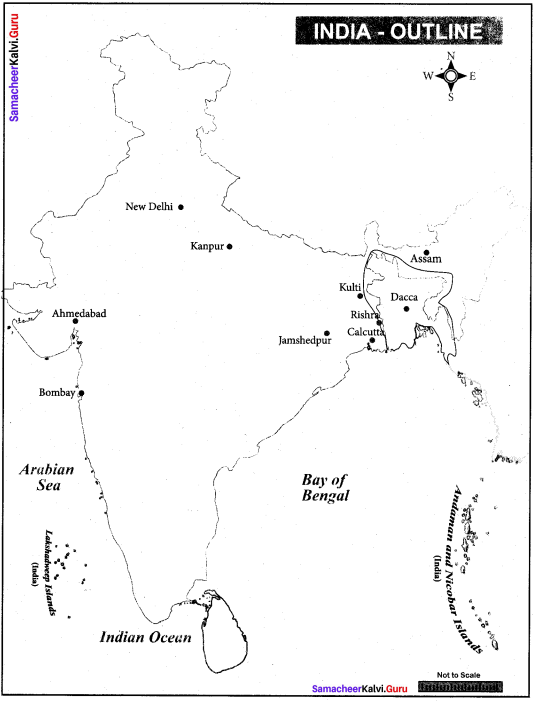
X. Project and Activity
Question 1.
Name the industries in your state and divide them into Agro based metal based and forest based.
Answer:
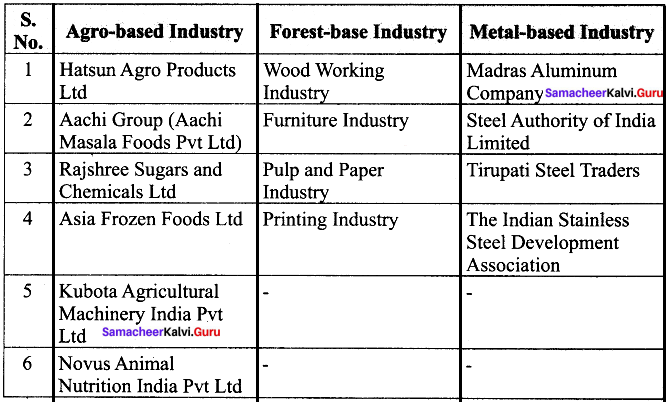
Question 2.
Prepare a project on air, water, and land pollution due to the industrial development in India.
Answer:
Activity to be done by the students.
Question 3.
Make a power point presentation on the industrial development of India and highlight the main features of those developments.
Answer:
Activity to be done by the students.
Samacheer Kalvi 8th Social Science Development of Industries in India Additional Questions
I. Choose the correct answer :
Question 1.
The ………….. in India has a rich history.
(a) Craft
(b) Steel
(c) Agricultural
(d) None of these
Answer:
(a) Craft
Question 2.
Saurashtra was known for ………………
(a) Tin Industry
(b) Bell Metal
(c) Muslin Clothes
(d) None of these
Answer:
(b) Bell Metal
Question 3.
Dacca was identified with ………….
(a) Tin Industry
(b) Muslin Clothes
(c) Bell Metal
(d) All of these
Answer:
(b) Muslin Clothes
Question 4.
The Tradition Indian Industry was known in the fields of …………..
(a) textiles
(b) woodwork
(c) ivory
(d) all of these
Answer:
(d) all of these
Question 5.
Mummies in …………. tombs dating from 2000 BC were found wrapped in Indian muslins of the finest quality.
(a) Egyptian
(b) British
(c) Spanish
(d) None of these
Answer:
(a) Egyptian
Question 6.
A 50 meters of this thin fabric could be squeezed into a …………..
(a) dress
(b) matchbox
(c) tin
(d) all the above
Answer:
(b) match box
Question 7.
………… industry was the oldest industry in India.
(a) Steel
(b) Jute
(c) Textile
(d) Sugar
Answer:
(c) Textile
Question 8.
Poverty of the Indian people was due to the British exploitation of India’s resources and the drain of India’s wealth to …………
(a) England
(b) Britain
(c) Egyptian
(d) All the above
Answer:
(b) Britain
Question 9.
Free trade policy followed by the ………….
(a) India
(b) England
(c) East India Company
(d) Both ‘a’ and ‘b’
Answer:
(c) East India Company
Question 10.
The process of Industrialization started in India from the mid ………..
(a) 18th Century
(b) 19th Century
(c) 20th Century
(d) 21st Century
Answer:
(c) 20th Century
Question 11.
The beginning of modern industry is associated with the development in mainly plantation like …………
(a) jute
(b) cotton
(c) steel
(d) all of these
Answer:
(d) all of these
Question 12.
The ……….. was the first to attract the Europeans.
(a) Machine based Industries
(b) Plantation Industries
(c) Heavy Industries
(d) None of these
Answer:
(b) Plantation Industries
Question 13.
The Assam Tea Company was founded in ……………
(a) 1839
(b) 1939
(c) 1739
(d) 1840
Answer:
(a) 1839
Question 14.
The Tata Iron and Steel Company (TISCO) was setup in …………..
(a) 1905
(b) 1906
(c) 1907
(d) 1908
Answer:
(c) 1907
Question 15.
In India, Modern Industrial sector in an organised form started with the establishment of cotton textile industry at ……….. in 1854.
(a) Madras
(b) Calcutta
(c) Delhi
(d) Bombay
Answer:
(d) Bombay
Question 16.
The First Paper Mill was started in …………. near Calcutta in 1870.
(a) Ballygunj
(b) Rishra
(c) Kanpur
(d) Jamshedji
Answer:
(a) Ballygunj
Question 17.
Steel was First manufactured by modern methods at Kulti in ………….
(a) 1843
(b) 1874
(c) 1865
(d) 1878
Answer:
(b) 1874
Question 18.
The year 1991 undered a new era of the ……………..
(a) Modernisation
(b) Industrialization
(c) Economic liberalisation
(d) None of these
Answer:
(c) Economic liberalisation
Question 9.
The New Policy welcomes ……………
(a) Craft
(b) Foreign Investment
(c) Agriculture
(d) All of these
Answer:
(b) Foreign Investment
Question 20.
………….. is an important component of economic growth.
(a) Modernisation
(b) Privatisation
(c) Liberalisation
(d) Industrialisation
Answer:
(d) Industrialisation
II. Fill in the blanks
- ………….. industry was started in Hoogly valley at Rishra near Culcutta
- The …………. and ………… factories become prominent in Kanpur.
- The ………… tea company was founded in 1939.
- The steel was first manufactured by modern methods at ………..
- ………… for tin industry.
- The Second largest source of employment in Rural India next to agriculture is ……….
- The British conquest transformed Indian economy (self-reliant) into ………economy.
- The accelerated industrialization began with the development of ……….. and ……………
- The length of ………….. increased from 2,573 Km in 1861 to 55,773 Km in 1914.
- ………….. mills were opened in Bombay and Ahmadabad.
- The heavy industries included the ……….. and ……….. industry.
- Iron and steel industries began rooted in the Indian soil in the beginning of ………. century.
- Industrial Policy Resolution 1956, industries were classified into ………. categories.
- ………….. skills were short in supply.
- Very important aim of the first three five year plans were ……………. India.
- A new era of the economic liberalization in …………..
- The …………. policy welcomes foreign investments.
- …………. has now a large verity of industries producing goods of varied nature
- Give example for primary sector ……….
- There was a limited development of mining, especially …………
Answer:
- Jutej
- Wollen and leather
- Assam
- Jamshedpui
- Vanga
- Handicrafts
- colonial
- roadways and railways
- railways
- Cotton
- Iron and Steel
- 20th Century
- Three
- Technical
- Strong Industrial
- 1991
- New
- India
- agriculture
- coal
III. Match the following:
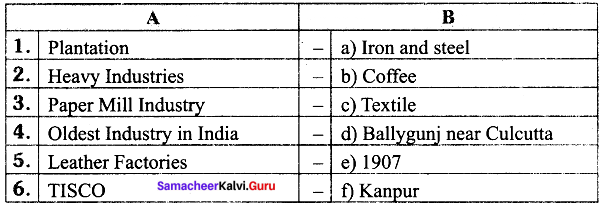
- b
- a
- d
- c
- f
- c
IV. State True or False:
- Jute industry was started in the Hoogly ally at Rishra near Punjab.
- Suez canal shortened the distance between Europe and India.
- The Assam Tea Company was founded in 1939.
- The expand form of TISCO – True Iron and Steel Company.
- Cotton Mills were opened in Bombay and Ahmadabad.
- India was famous for its quality of cotton and silk clothes.
- Saurashtra was known for Dacca.
- Vanga was known for tin industry.
- India become the market for the finished products of Britain.
- During the first half of 19th Century western countries were industrialization.
Answer:
- False
- True
- True
- False
- True
- True
- False
- True
- True
- True
V. Consider the following statements and Tick the appropriate answer
Question 1.
Which of the following statements are correct?
(i) The village artisans such as potters, weavers, smiths produced articles and utensils for domestic use.
(ii) Dacca was identified with muslin clothes.
(iii) The process of industrialization started In India from the mid-18’ century.
(iv) The plantation industry was the first to attract the Europeans.
(a) (i), (ii) & (iii) are Correct
(b) (i), (iii) & (iv) are Correct
(c) (i), (ii) & (iv) are Correct
(d) (i), (ii), (iii) and (iv) are Correct
Answer:
(c) (i), (ii) and (iv) are Correct
Question 2.
Assertion (A) : Indian became the market for the finished products of Britain.
Reason (R) : The British conquest transformed Indian Economy (self-reliant) into colonial economy.
(a) A is correct and R is the correct explanation of A
(b) A is correct but R is not the correct explanation of A
(c) Both A and R are correct
(d) Both A and R are wrong
Answer:
(b) A is correct but R is not the correct explanation of A
Question 3.
Which one of the following is correctly matched?
(a) Shajahan – Jamshedpur
(b) Bombay – First Textile Industry
(c) TISCO – Bernier
(D) 1991 – New Agricultural Policy
Answer:
(b) Bombay – First Textile Industry
Question 4.
Which one of the following is wrongly matched?
a) Paper Mill – Muslin
(b) Smiths – Artisan
(c) Drain Theory – The British exploitation of India’s resources
(d) De – industrialisation – 19th Century
Answer:
(a) Paper Mill – Muslin
VI. Answer the following one or two sentences
Question 1.
Write a short note on industrial development during 1965 – 1980.
Answer:
- As the first three five year plans mostly focused on the development of the capital goods sector, the consumer goods sector was neglected.
- The consumer goods sector is the backbone of rural economy.
- As a result, there was a fall in the growth rate of industrial production.
Question 2.
Classify the Industries on the basis of raw material.
Solution:
On the basis of raw material used, industries can be classified into –
- Agro – based Industries
- Mineral – based Industries
Question 3.
When and where was the first paper mill started?
Answer:
The first paper mill was started in Ballygunj near Calcutta in 1870.
Question 4.
Write any two machine based industries started in India.
Answer:
- In India modern industrial sector in an organised form started with the establishment of cotton textile industry in Bombay in 1854.
- In 1855, Jute industry was started in the hooghly valley at Rishra near Calcutta.
Question 5.
Write about the Muslin of Dacca.
Answer:
- Mummies in Egyptian tombs dating from 2000 BC (BCE) were found wrapped in Indian muslins of the finest quality.
- A 50 meters of this thin fabric could be squeezed into a match box.
Question 6.
What happen to Indian handicrafts under the colonical rule?
Answer:
Indian handicrafts that had made the country famous collapsed under the colonical rule.
Question 7.
Which is an important component of economic growth?
Answer:
- Industrialization is an important component of economic growth.
- India’s industrial expansion over the plan period presents a mixed picture.
Question 8.
Write about Indian road network.
Answer:
- The Indian road network has become one of the largest in the world.
- Government efforts led to the expansion of the network of National Highways, State highways and major district roads, which in turn has directly contributed to industrial growth.
Question 9.
Classify the Industries oh the basis of ownership?
Answer:
On the basis of ownership it can be classified into –
- Public Sector
- Private Sector
- Joint Sector and
- Co – operative Sector
Question 10.
What are the specialized goods produced by the Traditional Crafts?
Answer:
Some specialized goods produced by the traditional crafts are:
- Cotton textiles
- Muslin
- Wool
- Silk and
- Metal articles
VII Answer the following in detail
Question 1.
Explain the phases of Industrial development in India.
Answer:
1. Industrial development during 1950’s to 1965:
- During this phase, a majority of consumer goods were produced in India.
- The Industrial sector was underdeveloped with weak infrastructure.
- The first three Five-Year plans were very important because their aim was to build a strong industrial base in independent India.
2. Industrial development during 1965’s – 1980:
- As the first three Five-year plans mostly focused on the development of the capital goods sector, the consumer goods sector was neglected.
- The consumer goods sector is the beck bone of rural economy.
- As a result, there was a fall in the growth rate of industrial production.
3. Industrial development during 1980’s till 1991:
- The period of the 1980’s can be considered as the period of the industrial recovery.
- This period witnessed quite a healthy industrial growth.
4. Industrial development post 1991 Reforms:
- The year 1991 ushered a new era of the economic liberalization.
- India took major decision to improve the performance of the industrial sector.
- The Tenth and Eleventh Five-year plans witnessed a high growth rate of industrial production.
- The new policy welcomes foreign investments.
Question 2.
Discuss about the Traditional Crafts of India.
Answer:
- The Crafts in India has a rich history. Crafts were an integral part in the life of the people.
- Before arrival mechanized industry, the production of Indian handicrafts was the second largest source of employment in Rural India next to agriculture.
- The traditional Indian industry was known in the fields of textiles, woodwork, ivory, stone cutting, leather, fragrance wood, metal work and jewellery.
- The village artisans such as potters, weavers, smiths produced articles and utensils for domestic use.
- Some specialized goods were produced for cotton textiles, muslin, wool, silk and metal articles.
- India was famous for its fine quality of cotton and silk clothes.
- There are references made in many scholarly works to the professions of the weaver, the tailor and the dyer.
- Certain centers of metal industry well quite well known.
- For example, Saurashtra was known for bell metal, Vanga for tin industry and Dacca was identified with muslin clothes.
Question 3.
Write in detail about the Heavy Industries.
Answer:
- The heavy industries included the iron and steel industry, steel was first manufactured by modem methods at Kulti in 1874.
- Iron and steel industries began rooted in the Indian soil in the beginning of 20th century.
- However, the credit for the development of large-scale manufacture of steel in India goes to Jamshedji Tata.
- The Tata Iron and steel company (TISCO) was setup in 1907 at Jamshedpur,
- It started producing pig iron in 1911 and steel ingots in 1912.


